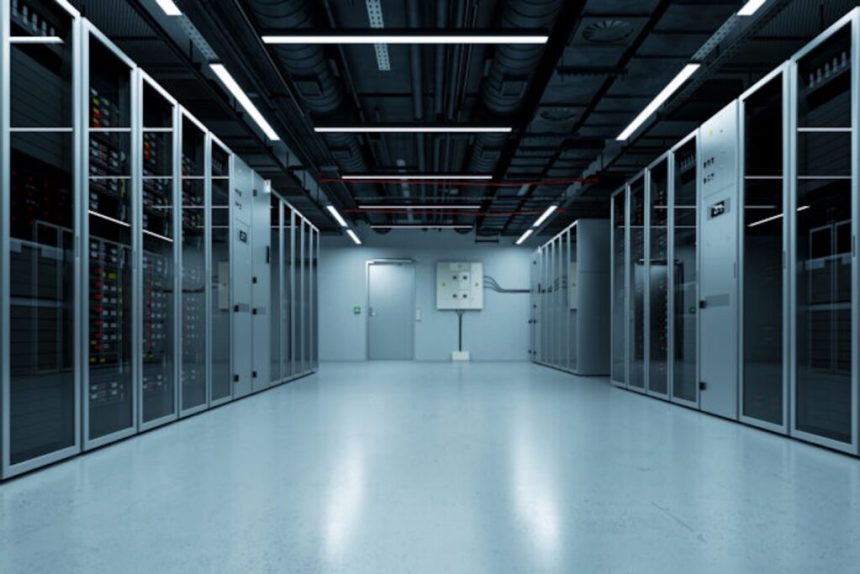The rise of artificial intelligence is driving the demand for data centers. (Getty Images)
As data center development takes off across the United States and the world, New Hampshire legislators and regulators are weighing what steps their state, and its aging electric grid, should take to prepare.
“For me, it’s worth considering. There may be an opportunity here, but I think there’s also concerns,” said Sen. David Watters, a member of the Senate Energy and Natural Resources Committee.
Data centers — large, energy-hungry facilities housing computer networks — are rapidly becoming more common nationwide, data center developer Craig McGahey told New Hampshire lawmakers and energy professionals at the 2025 New Hampshire Energy Summit, organized by consulting and lobbying firm Dupont Group on Sept. 15.
The rise of artificial intelligence is the biggest factor contributing to increasing data center demand, McGahey said, citing competition among so-called “hyperscalers” — expansive cloud computing companies like Google, Meta, OpenAI, and others.
“As this race for AI dominance continues, we don’t see it stopping, and it’s going to continue on for many, many years,” he said.
Nationally, construction of data centers is at an all-time high, Reuters reports. And as of March 2025, the United States had more of the facilities than any other nation, according to a Statista tally.
In other states, some of which have hundreds of data centers, the facilities have strained electric grids and, in some cases, water supplies. Yet, for now, New Hampshire is not among those: 10 relatively small-scale facilities were listed statewide on the website Data Center Map as of September 2025, putting New Hampshire in the bottom fifth nationally.
Some see an ‘emerging market.’ Others, an environmental threat.
That may, however, be set to change. Low power availability and high electricity costs have so far been the principal factors preventing an influx of data centers in New Hampshire like that seen in some other states, McGahey said. But he added that he considered the Northeast as a whole an “emerging market” for the centers.
Developers like himself, he said, were assessing different states’ regulatory landscapes, land availability, and power supplies to determine where to site new centers, which can range in size from normal office buildings to projects spanning hundreds of acres.
Lawmakers are divided on whether data center development would be an opportunity or a concern for New Hampshire.
Citing property tax revenue and employment benefits, some legislators said they wanted to see New Hampshire create a regulatory environment that would favor data centers.
“I think New Hampshire should court any business into the state,” said Rep. Doug Thomas, vice chair of the House Science, Technology, and Energy Committee, in an interview. “In order for them to come here, there has to be a market. And so we have to … show them that we’re interested.”
He and House Science, Technology, and Energy Committee Chair Michael Vose cited construction and jobs as a primary benefit of growing data centers in New Hampshire. In his presentation, McGahey said a data center of the scale likely to be established in New Hampshire could employ as many as 40 people full-time, and potentially hundreds more during construction.
Others questioned whether those estimates represented enough jobs to make a meaningful impact on employment. Rep. Thomas Cormen, a member of the House Science, Technology, and Energy Committee, said in an interview the amount of people employed by data centers does not typically scale up proportionally as the centers increase in size. And, he added, for a relatively uncomplicated building like the typical warehouse-style data center, the construction phase might not last particularly long, meaning the bulk of jobs created would be temporary.
Watters said data center jobs were not substantially better-paying than jobs in other preexisting industries. “Some of the biggest ones employ maybe 100 to 200 people at a $40,000 (annual) salary,” Watters said. “I mean, that’s McDonalds. … They might make close to $40,000, too.”
Cormen also raised environmental concerns. Some data centers are cooled with river water, a practice that raises the temperature of the water downstream, Cormen said. This could be harmful to the river itself or cause dangerous ice dams and flooding in winter, he said.
“I think a lot of people have environmental concerns, and power concerns,” Watters said.
Uncertainty about how data centers would be powered, Cormen said, is another hurdle; while drawing from the grid could raise electricity costs for other ratepayers, the type and effects of unregulated local generators are another unknown.
“Before you know it, we’re talking about diesel generation,” he said. “We just don’t know.”
Speculating to meet demand
Some states have weighed implementing special rate schedules to offset the impact of increased on-grid data center demand on ratepayers, but Vose said he did not expect the New Hampshire Legislature to consider such a system in the near future.
Instead, Vose and other legislators discussed ways to increase New Hampshire’s electricity generation down the road, including through speculative technology like small, modular nuclear reactors, or SMRs.
The New Hampshire Department of Energy is assessing whether SMRs could someday be implemented in New Hampshire, Director of Energy Innovation Thomas Barrasso said at the summit. SMRs could power data centers within “microgrids,” small regionalized power grids that could operate either independently of or in tandem with the rest of the grid, he said.
“I think the microgrid piece of this, the grid modernization piece of this, the SMR piece of this kind of all start to fit together,” Barrasso said.
At the summit, Barrasso expressed optimism about small modular reactors, saying he felt the tide of public opinion toward nuclear energy was changing. A Gallup poll published in April supported this impression, showing 61% of Americans in favor of nuclear power — a six percentage point increase over the previous poll in 2023.
However, SMR critics point out that the technology is still in development, questioning Barrasso’s statement at the summit that they could eventually be “plug and play” solutions to bolster New Hampshire’s energy offerings. It may be anywhere from five to 15 years before the generators could hypothetically be deployed, according to Barrasso’s presentation.
SMRs are a “convenient” discussion for people resistant to renewable energy development, Watters said in an interview. “The interest is being driven by people who think SMRs are the answer to every problem in the world,” he said. But they are not the only way data centers could be powered, he noted.
Other technologies, including forms of renewable energy, are deployable now and could be implemented with less investment, said Dan Weeks, of solar developer ReVision Energy, at the summit. Weeks highlighted grid-scale batteries and renewable generation as other options that the state could direct attention to rather than the hypothetical future deployment of SMRs.
“Is the (Department of Energy) thinking about meeting these rising energy needs and cost concerns through … greater deployment of existing technologies that are at this point pretty far down the cost curve and probably a lot closer in the future than SMRs?” Weeks asked.
“My job was to sort of get ‘all of the above’ into the mindset of everyone,” Barrasso responded.
The Legislature has already taken some steps toward localized power generation that could be used to power facilities like data centers through SMRs. House Bill 672, sponsored by Vose and signed by Gov. Ayotte in August, paved the way for off-grid energy generators to sell power directly to buyers. Vose said he hoped that bill would “encourage” microgrids. (The bill also exempts off-grid electricity providers from renewable energy standards and the rate regulations on-grid generation is subject to.)
A resolution to declare the development of advanced nuclear technology “in the best interest of New Hampshire” also passed last session, but legislators failed to pass House Bill 710, which would have allowed utilities to own and operate SMRs. A similar bill sponsored by Sen. Kevin Avard will come before the Legislature in 2026, according to a legislative service request listed on the General Court of New Hampshire website.
McGahey acknowledged the push to build data centers quickly had led developers to look toward more quickly deployable energy solutions than SMRs. In other states, developers have constructed new gas generators to meet data center demand, he said.
“Because this race is so intense, we’re looking for solutions in two to three years. We are looking at battery storage solutions. We’re looking at natural gas plants,” McGahey said.
Looking ahead
During his presentation, McGahey forecasted demand for a wave of smaller data centers within the next three to five years. The appetite of New Hampshire policymakers and utilities toward that development, McGahey said, could play a role in determining to what extent that development progresses locally.
The reality that New Hampshire’s grid is facing, including difficulties from power shortages and aging transmission lines, may make it unlikely that the state ever sees data center development on a large scale, Watters said.
“It’s hard for me to imagine that there’d be an interest in siting them here,” he said.
But the possibility, and related concerns, were worth discussing, he said, and others at the summit agreed.
“We need to get people to the table to start to talk about what the future is going to look like,” Barrasso said.









